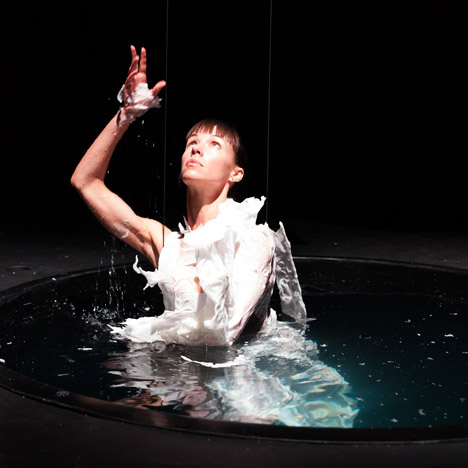Lisbon Architecture Triennale: people are dunked in a pool of wax to create sculptural dresses by Dutch fashion designer Bart Hess as part of a futuristic city on show at this year's Lisbon Architecture Triennale, which kicked off yesterday in the Portuguese capital.
Bart Hess created the installation to explore ways in which humans can augment and extend the shapes of their bodies, creating a kind of prosthetic that is unique each time.
To create the garment, individuals are strapped to a robotic harness then lowered into a pool of water and wax. As the wax moves in the water it begins to set, bonding itself around the body.
The person is then lifted out of the water, encased inside a cocoon of wax that can then be cut or broken.
Speaking to Dezeen, Bart Hess explained that temperature affects the end result. "More complex shapes require hotter temperatures, so you need to build up a tolerance to the heat," he explained. "But it only hurts on the surface for a few seconds."
The Garment District is one of five zones in the Future Perfect exhibition, which was conceived by curator Liam Young as an exploration into how technology will shape future cities.
"Telling stories about the future is a way of thinking about ideas," said Young. "It's about opening up a a discourse of what a city could be. Architects need to be operating beyond the now, developing strategies and tactics that will connect people with the future."
The Lisbon Architecture Triennale continues until 15 December. Follow Dezeen's coverage of the event »
Earlier this year Dutch fashion designer Iris van Herpen creates a dress modelled on splashing water. See more stories about fashion »
Here's a short project description from the exhibition organisers:
The Garment District
Our bodies are endlessly photographed, monitored and laser scanned with millimetre precision. From this context of surveillance, facial recognition, avatars and virtual ghosts, we imagine a near future where digital static, distortions and glitches become a new form of ornament.
For the youth tribes of Future Perfect the body is a site for adaption, augmentation and experimentation. They celebrate the corruption of the body data by moulding within their costumery all the imperfections of a decaying scan file. Shimmering in the exhibition landscape is a network of geometric reflective pools of molten wax. Their mirrored surface is broken by a body, suspended from a robotic harness, plunging into the liquid. A crust of wax crystallises around its curves and folds, growing architectural forms, layer by layer, like a 3d printer drawing directly onto the skin. Slowly the body emerges, encased in a dripping wet readymade prosthetic. It is a physical glitch, a manifestation of corrupt data in motion, a digital artefact. They hang from hooks like a collection of strange beasts and frozen avatars. Body prints, imperfect and distorted and always utterly unique.

